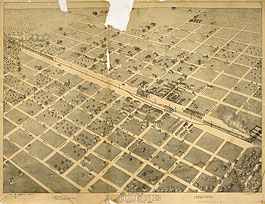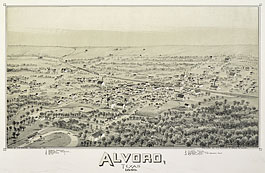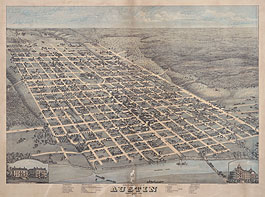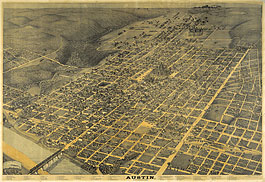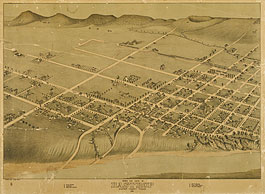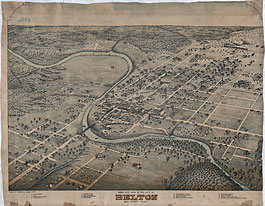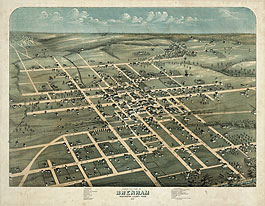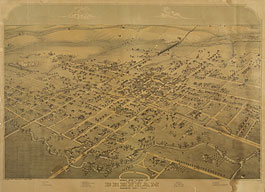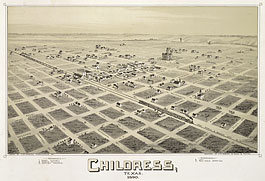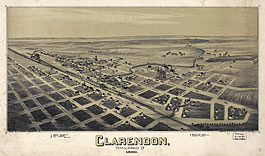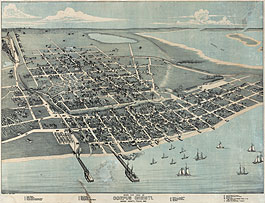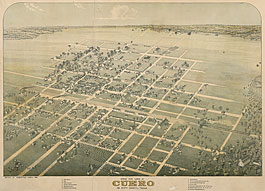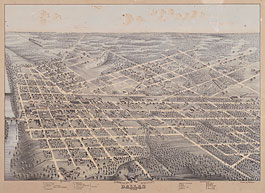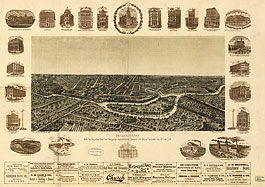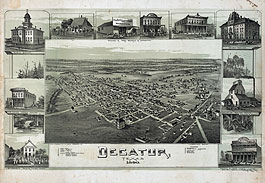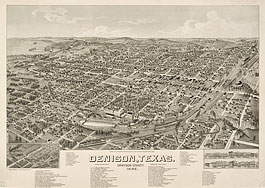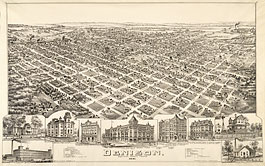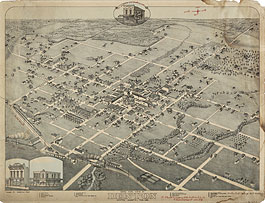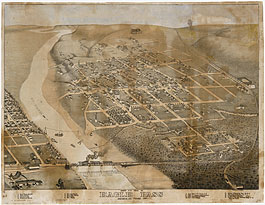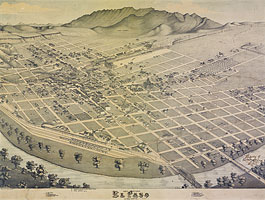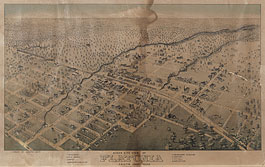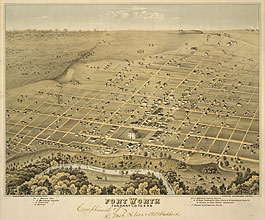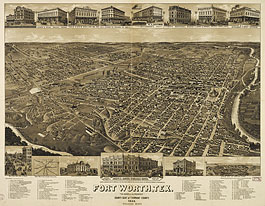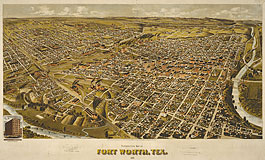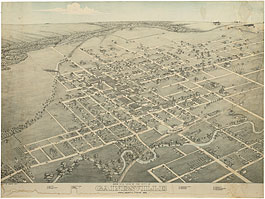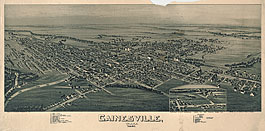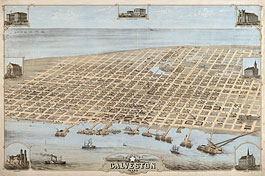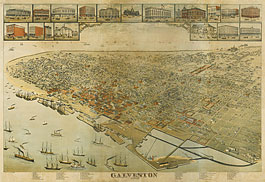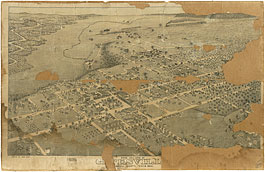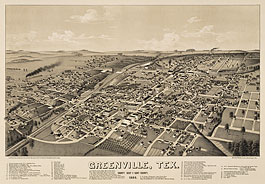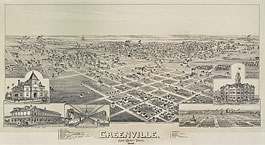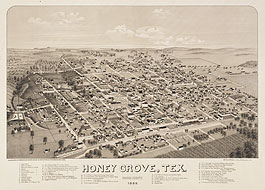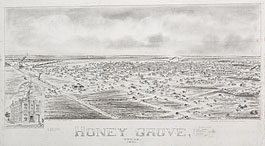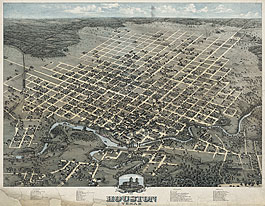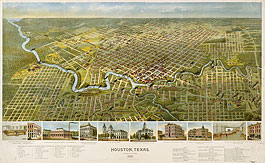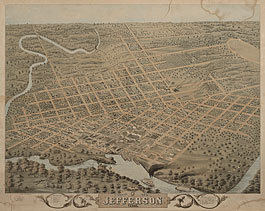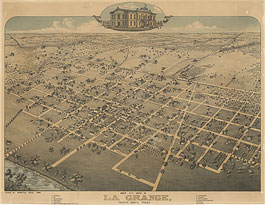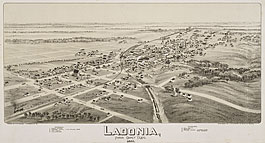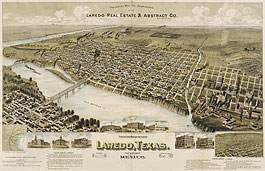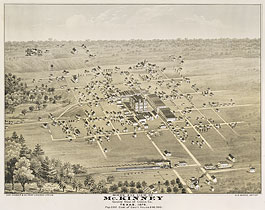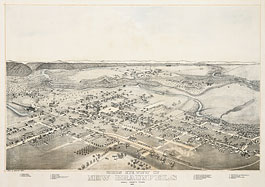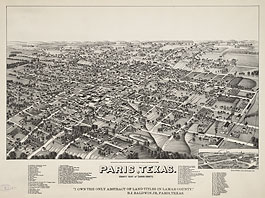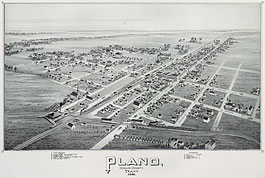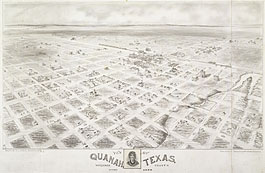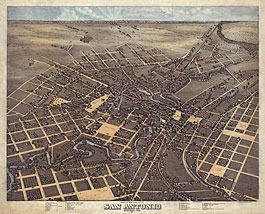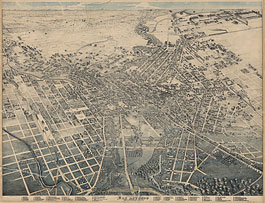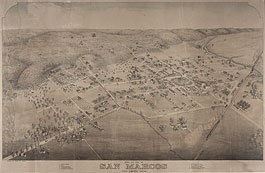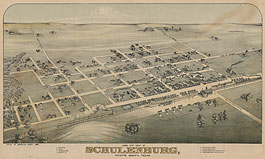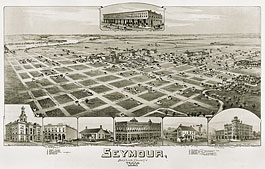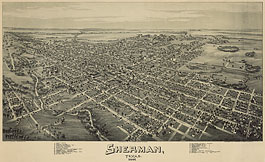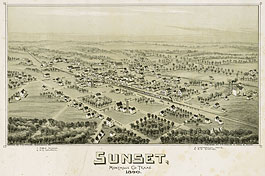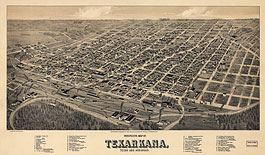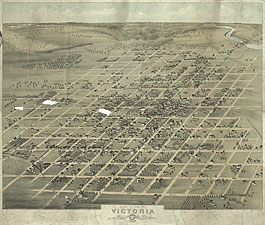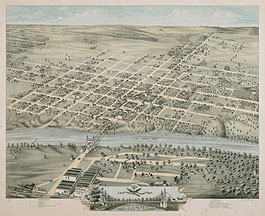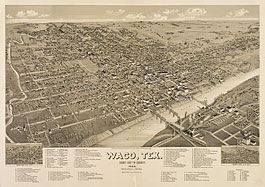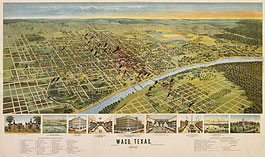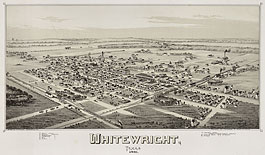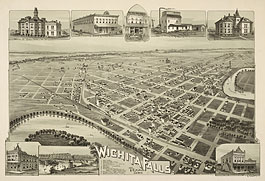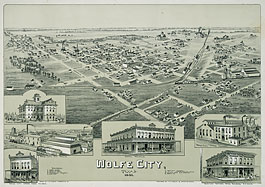Abilene in 1883
Abilene came into being as the Texas and Pacific Railway rapidly built its way from Fort Worth across West Texas. As the railroad industry recovered from the Panic of 1873, New York financier and railroad magnate Jay Gould organized a syndicate to provide new investment muscle for the T&P, and he put engineer and former General Grenville M. Dodge in charge of construction. Work began in Fort Worth on… [More]
Alvord in 1890
The Fort Worth and Denver City Railway reached Alvord, about 13 miles from Decatur, early in 1882 as a part of the company’s pell-mell rush to meet the construction crews from Denver in the Texas Panhandle. The small Wise County town had begun life as Nina, a tent city on the railroad about fifty miles north-northwest of Fort Worth. It was named Alvord in honor of the president of… [More]
Austin in 1873
Austin had been designated the permanent capital of the state just a few months before Augustus Koch, one of the most prolific of the itinerant city-view artists, arrived in town in January 1873, and the city was experiencing a boom. The view that Koch proposed to the editor of the Daily Democratic Statesman would be a tangible expression of the city’s new-found pride as the population grew steadily and… [More]
Austin in 1887
Koch paid a return visit to Austin in 1887. The city was much larger by then—in the ensuing fourteen years, the population almost doubled to well over 11,000—and Koch reflected that in a print even larger than the one he had made of San Antonio. The eye easily traces the new growth in a diagonal line from lower left to upper right: from the reconstructed bridge over the Colorado… [More]
Bastrop in 1887
During what might have been his fourth tour of Texas, Augustus Koch paused to sketch a bird’s-eye view of Bastrop, a small city of approximately 2,000 persons about thirty miles southeast of Austin. The city is located on the east bank of the Colorado River on a bluff that is generally level until it rises gently to form the low hills east of town, home to the remnants of… [More]
Belton in 1881
Located on Nolan Creek, a tributary of the Leon River, Belton, the county seat of Bell County, was a small town of fewer than 1,800 persons when Koch visited in 1881. But the town was already rebounding from the economically disastrous years of the Civil War and a terrible fire of the year before that had destroyed much of the downtown area. The nearby Chisholm Trail, which ran along… [More]
Brenham in 1873
Augustus Koch’s view of Brenham in 1873 shows a city that emerged from the throes of the Civil War and Reconstruction with some confidence that it would continue to prosper. As with other contemporary views, the railroad occupies a significant place in the geography and future of the city. Washington County citizens organized the Washington County Railroad to link with the Galveston and Red River Railway (later the Houston… [More]
Brenham in 1881
The Brenham that Koch depicted in 1881 had been rebuilt since the disastrous 1873 fire had destroyed much of the downtown area, and the railroad had enlarged Brenham’s trade area and stimulated its growth, including a significant immigration from Germany. Between June 1878 and June 1879, for example, more than 100 new houses were built within the city limits, and new businesses and churches were established to serve the… [More]
Childress in 1890
Traveling along the Fort Worth and Denver City Railroad, Thaddeus Fowler reached Childress, in Childress County a few miles south of the Prairie Dog Town Fork of the Red River. Childress County had been organized during the 1880s as the railroad was built through the region. Childress City and Henry, two fledgling communities about four miles apart, competed for county seat, and Childress City won the election. This meant… [More]
Clarendon in 1890
Clarendon, the county seat of Donley County just east of the Llano Estacado, is the westernmost city in Texas that Fowler documented. The city was founded as a religious colony in 1878 and named either after Clara, the wife of Methodist minister and founder, Lewis Henry Carhart, or perhaps after Clarendon, England, to honor an English firm that backed Carhart’s endeavor. Carhart purchased 343 sections of land in the… [More]
Corpus Christi in 1887
Although various Indian bands had inhabited the area at the mouth of the Nueces River for centuries, the Spaniards never successfully settled Corpus Christi. Anglo merchants established a trading post there in 1839, following the war between the United States and Mexico, but it did not prosper until the decade of the 1870s, when sheep and cattle ranching became widespread in South Texas, with Corpus Christi as the primary… [More]
Cuero in 1881
Cuero in 1881 was the center of a region of small farmers who raised cotton, corn, sweet potatoes, and livestock. Although there had been a village known as Cuero as early as 1846, the present site of the city was established when the Gulf, Western Texas and Pacific Railway arrived from Indianola and Victoria en route to San Antonio in 1873, and the county seat was relocated from nearby… [More]
Dallas in 1872
When William H. Patchen, Herman Brosius’ agent, arrived in Dallas in December 1872, he had with him a copy of the newly printed view of Jefferson by Brosius as well as a sketch of Dallas that Brosius had just finished. He had, too, a proposal that if the local citizens would subscribe for a sufficient number of copies, he would produce a colored lithograph of Dallas similar to the… [More]
Dallas in 1892
By 1892, Dallas had had rail service for twenty years, time enough to witness the often-repeated practice of railroads lowering their freight rates to drive river transportation out of business, then raising the rates again. Not that Dallas ever had effective river transportation, but community leaders had tried several times, beginning in the 1840s, to get Congress to provide federal funds for the improvement of the Trinity River. When… [More]
Decatur in 1890
The Fort Worth and Denver City Railroad, linking Fort Worth with West Texas and finally with Denver, provided Thaddeus Fowler the opportunity to document the massive movement of population into West Texas during the last two decades of the nineteenth century. The use of barbed wire and windmills had rendered semi-arid West Texas somewhat less formidable, and farmers using relatively new dry-land techniques had brought cotton to the Panhandle… [More]
Denison in 1886
Henry Wellge was an experienced bird’s-eye-view artist by the time he began his Texas tour in 1885. With more than fifty prints to his credit, he produced an India-ink drawing of Denison, more or less the northern entrance into Texas, that one correspondent claimed “shows at a glance the character of the country, the location and development of our city.” Denison was a city literally built by the railroad… [More]
Denison in 1891
Thaddeus Fowler perhaps began his second tour of Texas with his picture of Denison, a growing city with a population approaching 11,000 by 1891. On January 11, The Sunday Gazetteer reported that the artist had been in the city for several weeks making pencil sketches for the new bird’s-eye view, which would be much larger than previous views of the city. “It is believed to include every residence within… [More]
Denton in 1883
Denton was established in 1857 to serve as the county seat of Denton County. Anglo-American settlement in the region had begun with the Peters colony grant in 1841, but the community, based on sustenance agriculture, grew slowly until the arrival of the railroads in 1881.The population of the city more than doubled to 2,558 in the ensuing decade. The railroad connections to Sherman, Dallas, and Fort Worth provided farmers… [More]
Eagle Pass in 1887
Augustus Koch’s bird’s-eye view of Eagle Pass is dominated by the Rio Grande on the left side of the picture; the Galveston, Harrisburg and San Antonio Railway at the right and bottom; and Fort Duncan in the lower right-hand corner. An unnamed creek separates the city from the fort.
Eagle Pass began in 1850 when a settlement grew up around Fort Duncan, which had been established the previous year on… [More]El Paso in 1886
Throughout its history prior to 1881, El Paso-area business had been dominated by its location on the north-south Camino Real that connected Mexico City with Chihuahua and Santa Fe. With the arrival of the Southern Pacific Railroad in May 1881, however, the city got a direct rail connection with the West Coast, and when the Southern Pacific connected with the Texas and Pacific at Sierra Blanca the following December… [More]
Flatonia in 1881
The area around Flatonia was settled by Anglo-Americans prior to the Civil War, but inexpensive land gradually brought German, Bohemian, Greek, Arabian, and Italian immigrants into the region. The city itself was created by the Galveston, Harrisburg and San Antonio Railway as it built west through Fayette County from Schulenburg in April 1874. Residents of old Flatonia, one mile southeast of the new site, and Oso, three miles northeast… [More]
Fort Worth in 1876
Artist D. D. Morse arrived at a propitious moment in the history of Fort Worth. In April 1876, when he drew this classic bird’s-eye view from the northwest, the village, buffeted by the effects of the Civil War and economic depression, was struggling for its very existence. Established in 1849 as one of a series of military posts in the frontier defense system, the settlement had suffered the abandonment… [More]
Fort Worth in 1886
The arrival of the railroad ushered in an era of astonishing growth for Fort Worth as migrants from the devastated South continued to swell the population and small, community factories and mills yielded to larger businesses. Newly dubbed “Queen City of the Prairies,” Fort Worth supplied a regional market via the growing transportation network. More smokestacks are evident in Henry Wellge’s 1886 view, which the editor of the Fort… [More]
Fort Worth in 1891
The fact that Henry Wellge was back in Fort Worth in 1891 to revise his 1886 view demonstrates the concern the city fathers had in promoting the city, as they tried to recover from the difficult economic conditions. Again depicting the city from the northeast, Wellge showed the same basic area as in the 1886 print, suggesting that he might have used the earlier print as a pattern for… [More]
Gainesville in 1883
The Gainesville that Augustus Koch depicted in 1883 was a prosperous cattle town, with a large courthouse and public school building financed by income from the cattle business. The first Anglo-American settlers arrived in the area, on the western border of the Eastern Cross Timbers, where “the magnificent roll of the prairie is broken abruptly off against the woody rim,” in the 1840s, and the city was founded as… [More]
Gainesville in 1891
Gainesville continued to grow in the years between Augustus Koch’s visit in 1883 and Thaddeus Fowler’s in 1891, due partly to the arrival of two additional railroads: the Santa Fe in 1886 and the Gainesville, Henrietta and Western Railway in 1887. Almost 6,600 persons called the city their home by 1890, perhaps double the population of 1883. Unlike some communities that suffered when the trail drives came to an… [More]
Galveston in 1871
The bird’s-eye-view phenomenon began in Texas when the editor of the Galveston Daily News announced in his March 10, 1871, edition that “Mr. C. Drie exhibited to us some drawings that he is making for a map of Galveston, which will exhibit the buildings on every lot within the city. It is an isometric projection, and promises to be a fine picture of the Island City, and will be… [More]
Galveston in 1885
Augustus Koch’s view of Galveston in 1885 reveals how much the city had grown in the fourteen years since Camille M. Drie depicted it in 1871. Shown from the northwest, both views focus on the downtown commercial district and the port facilities on Galveston Bay, the narrow strip of water between the mainland and the island. Galveston was the largest city in the state and the third largest cotton… [More]
Gatesville in 1884
As with many cities in the late 1800s, Gatesville was recovering from a fire. The rebuilding had already begun when Koch made this view, and the Texas and St. Louis Railroad, which initiated service from Waco in October 1882, had accelerated growth in this small Central Texas community. Gatesville was primarily a regional agricultural center, with Benjamin Worley’s Flour and Planing Mill and Cotton Gin operating on Still House… [More]
Greenville in 1886
Wellge continued his tour of the North Texas cotton-farming country with a visit to Greenville late in 1885. Prior to the arrival of the railroads, Greenville had been what one historian called an “inland island,” thirty miles from a railroad in any direction and a modest producer of traditional agricultural crops. But an increase in the number of slaves before the Civil War and the arrival of the railroads… [More]
Greenville in 1891
For a city that waited longer than most for the railroad, Greenville had become a rail center by the time of Fowler’s visit in 1891. In addition to the Missouri, Kansas and Texas, the East Line and Red River, and the Dallas and Greenville railways, the St. Louis Southwestern arrived in 1887 and the Texas Midland in 1896, five years after Fowler’s view. Hunt County was no longer an… [More]
Honey Grove in 1886
Traveling eastward, probably on the Texas and Pacific Railroad, Wellge continued his tour of North Texas with a visit to Honey Grove, a little more than forty miles from Denison. The city got its name from a nearby grove of trees, where the early settlers found an apiary. The arrival of the T&P in 1873 had turned the village of about 300 persons into a small, regional center with… [More]
Honey Grove in 1891
Fowler included Honey Grove in his 1891 tour of North Texas and produced an elaborate drawing of the city, highlighted with blue pencil and wash, but there is no record that it was ever lithographed. Perhaps the economic situation had worsened for Honey Grove merchants and farmers since Henry Wellge’s 1886 visit; or perhaps they believed that Wellge’s handsome lithograph had not paid sufficient dividends and were unwilling to… [More]
Houston in 1873
Shortly after Texas won its independence on the nearby battlefield at San Jacinto in 1836, Augustus C. and John K. Allen founded Houston at the head of tide on Buffalo Bayou to be the leading metropolis of the new nation. Sam Houston, elected first president of the Republic of Texas, was honored to have the city named after him and considered the site “far superior” to all others for… [More]
Houston in 1891
A. L. Westyard’s view of Houston in 1891 documented the city as it began a decade of explosive growth—in population, growing from 27,557 in 1890 to 44,633 in 1900, as well as in area, with suburbs such as Magnolia Park appearing beyond the jurisdictional reach of the City Council but made convenient to the city center by rail transportation. Houston in the 1890s came face-to-face with the advantages and… [More]
Jefferson in 1872
As the bird’s-eye-view phenomenon coursed through the country, three additional artists arrived in Texas in the 1870s and produced views of more than a dozen different cities. Herman Brosius, the first bird’s-eye-view artist to follow Drie into the state, probably arrived in Jefferson in the spring of 1872 by steamboat from nearby Shreveport, Louisiana, where he had done a bird’s-eye view of that city. Jefferson was then one of… [More]
La Grange in 1880
Augustus Koch began his second tour of Texas probably in late 1880 with a drawing of La Grange, the county seat of Fayette County. Following Anglo-American immigration into the area in the 1820s, the region had quickly developed a plantation economy built on slavery and the fertile lands along the Colorado River. With increasing German and Wend immigration after the Civil War, the size of farms decreased, but their… [More]
Ladonia in 1891
The population of Ladonia, in the southeastern corner of Fannin County, numbered around 1,000 when Fowler visited in 1891 to make this view of the city. It is doubtful that there would have been a sufficient market for Fowler’s views among so few citizens themselves, in Ladonia or any of the other small towns that the bird’s-eye view artists documented. Perhaps several entrepreneurs or city officials took it upon… [More]
Laredo in 1892
The railroads brought prosperity and new settlers to Laredo when they arrived in 1881, and the city grew from an 1880 population of 3,521 to 11,319 in 1890. But instead of focusing on the railroads, as many other bird’s-eye-view artists had done, Henry Wellge emphasized the results of the railroads, which had turned Laredo into a growing city and the gateway to Mexico. The Texas Mexican Railway linked Laredo… [More]
McKinney in 1876
As with many other city views, the new courthouse and the railroad are the dominant features of D. D. Morse’s view of McKinney. The Houston and Texas Central Railway had arrived in October 1872, transforming the Collin County economy, and the new courthouse opened with a grand ball on January 1, 1876.
Morse might have made as many as ten bird’s-eye views before he arrived in Texas in 1876, but… [More]New Braunfels in 1881
In depicting New Braunfels, founded in 1845 under the auspices of the Adelsverein (also known as the Society for the Protection of German Immigrants in Texas), Augustus Koch chose the perspective from the Sophienburg (Fort Sophia), the headquarters that Prince Solms-Braunfels established for the colony. Built on a hill on the south side of the new settlement with a view of the Comal River and its confluence with Comal… [More]
Paris in 1885
Henry Wellge completed his large drawing of Paris, Texas—which one correspondent pronounced “very accurate in detail”—before the end of the year 1885. Working with George E. Norris, who was his partner and sales agent, they printed the image with the Beck & Pauli lithographic firm in Milwaukee late that year.
According to John H. Patterson, a reporter for Frank Leslie’s Illustrated Newspaper, Paris was the center of a… [More]Plano in 1891
Plano is known today as a suburb of Dallas, completely engulfed by the larger city along with other nearby communities. But in 1891 when Fowler made this view, Plano stood separate and apart, with an economy that had begun to develop as a result of the arrival of the railroads in the previous decades. The first Anglo-American settlers in Collin County, prior to the Civil War, engaged mainly in… [More]
Quanah in 1890 (drawing)
Like Henry Wellge’s drawing of Honey Grove, this drawing by Fowler of Quanah is very rare. Once completed, such drawings were then sent to a lithography studio, where artists translated them into multiple lithographic prints. In most cases, the one-of-a-kind sketches then disappeared. Along with its derivative lithograph, this drawing has added historical importance because Quanah was struck by both flood and fire the year after Fowler finished his… [More]
Quanah in 1890 (lithograp)
The fact that Quanah was named for the Comanche chief Quanah Parker testifies to the centuries of Indian presence in the area that became Hardeman County in 1858 and explains why there was little Anglo-American settlement in the area until the 1880s. That began to change in 1884 as the Fort Worth and Denver City Railway worked on the road beyond Wichita Falls. The railroad surveyors laid out Quanah… [More]
San Antonio in 1873
Unlike most Texas bird’s-eye views, Augustus Koch’s depiction of San Antonio does not include a train, because the railroad did not arrive in the Alamo City until 1877. The most obvious aspects of the city, viewed from the northwest, are its many public plazas and the winding San Antonio River. San Fernando Church is located on the west side of the Main Plaza, with the Bexar County Courthouse immediately… [More]
San Antonio in 1886
The railroads were slow to build to San Antonio. In 1877, Galusha Aaron Grow, president of the International-Great Northern Railway, suggested that San Antonio was “perhaps the largest city on the continent today that had remained so long without railroad connection”—and when railroads did arrive on the evening of February 19, 1877, they transformed the “old dry bones of the Alamo City.”
San Antonians had tried to lure a railroad… [More]San Marcos in 1881
San Marcos was still a small, country town when Augustus Koch documented it in December 1880 shortly after the International-Great Northern Railroad, shown on the right-hand side of the print, connected it with Austin and San Antonio. Anglo-American settlers had arrived at the site in the 1840s, and the city had developed as a regional milling and ginning center. Cattle and cotton had become its main products by 1870… [More]
Schulenburg in 1881
Schulenburg, located in southern Fayette County about eighteen miles south of La Grange, was a small town of fewer than 1,000 persons when Koch visited in 1881. It had been founded in 1873, when the Galveston, Harrisburg and San Antonio Railway built through that portion of the county, and was settled by German, Austrian, and Czech immigrants whose presence is documented in some of the street names such as… [More]
Seymour in 1890
The Seymour that Thaddeus Fowler depicted in 1890 seemed to be a prosperous county seat with more large, stone buildings than such a small community, which was not even listed separately in the census of 1890, might justify. The substantial buildings resulted from a boom that coincided with the construction of the Wichita Valley Railroad to Seymour, located on the Brazos River, in 1890. The boom began when the… [More]
Sherman in 1891
The Texas Legislature established Sherman as the seat of government for Grayson County in 1846, and by 1860 the city had incorporated and become an important trading center for farmers in the surrounding area. The growth continued with the arrival of the Houston and Texas Central Railway in 1872, but because the city did not offer enough support, the Missouri, Kansas and Texas line chose to establish a new… [More]
Sunset in 1890
Sunset was among the communities that benefited from the construction of the Fort Worth and Denver City Railroad through northeast Texas. Located about eight miles northwest of Alvord, Sunset dates from the 1870s, when a few settlers arrived from Denton County. When the FW&DC built its line through the county in 1882, several residents moved to the site of Sunset to be near the tracks, and the small community… [More]
Texarkana in 1888
Texarkana is located in a densely wooded area on a plateau between the Red and Sulphur rivers at the site of an old Indian trail that was for hundreds of years the main route between the Indian villages of the Mississippi River area and those to the west. The city was founded in December 1873 on the site where, hardly a month later, the Cairo and Fulton Railroad (from… [More]
Victoria in 1873
In 1873 Victoria was the principal city of Texas’ central coastal region and on the supply line from the Lavaca Bay ports to San Antonio and Austin. Located on the Guadalupe River, Victoria was also a river port, with steamboats serving the city as late as the 1880s. However, Brosius’ view—looking south toward the river in the far-right distance and the recently arrived Gulf, Western Texas and Pacific Railway… [More]
Waco in 1873
Brosius might have taken the train from Dallas southward to Waco, where he sketched that city just as it was rebuilding from a terrible 1871 fire that destroyed the downtown area known as “Rat Row,” between First Street and the Courthouse. Evident in the resulting reconstruction (and shown in the view) are some of the more substantial brick buildings that replaced the wooden structures. Fires were often good… [More]
Waco in 1886
Considerable growth had taken place in Waco from the time Herman Brosius produced his view in 1873 to 1886, when Henry Wellge provided a careful update in his view. Two more railroads—the Houston and Texas Central and the Missouri, Kansas and Texas—had built lines through the city, including two new railroad bridges over the Brazos River. Waco was in the process of becoming a transportation and commercial hub for… [More]
Waco in 1892
Although Waco was only the sixth largest city in the state in population in 1892—behind San Antonio, Dallas, Houston, Galveston, and Austin—it had grown to be one of the most important cotton markets in the South. According to one estimate, nearby farmers brought more than 40,000 bales of cotton to Waco to be ginned, and railroads brought another 80,000 bales from smaller cities that did not have their own… [More]
Whitewright in 1891
Like many other Texas cities, Whitewright owes its founding to the arrival of the railroad and the westward movement of cotton production out of deep East Texas. In 1878, as the Missouri, Kansas and Texas Railroad was making its way into the state, New York investor William Whitewright purchased a tract of land in the railroad’s right-of-way. He surveyed a town site and then brought in agents to conduct… [More]
Wichita Falls in 1890
The initial destination goal of the Fort Worth and Denver City Railroad as it built northwestward from Fort Worth toward the Texas Panhandle was Wichita Falls. The small community, which had attracted a scattering of settlers throughout the 1870s and established a post office in 1879, encouraged the railroad to build through the developing business district by donating land. The first construction train, with a single passenger car attached… [More]
Wolfe City in 1891
Wolfe City was founded in the late 1860s or early 1870s when J. Pinckney Wolfe built a mill near Oyster Creek in north-central Hunt County. For a while it was known as Wolfe’s Mill, but by the time it received a post office, the name had been changed to Wolfe City. Adding “city” to the name was an affectation that dozens of small towns in Texas and across the… [More]











